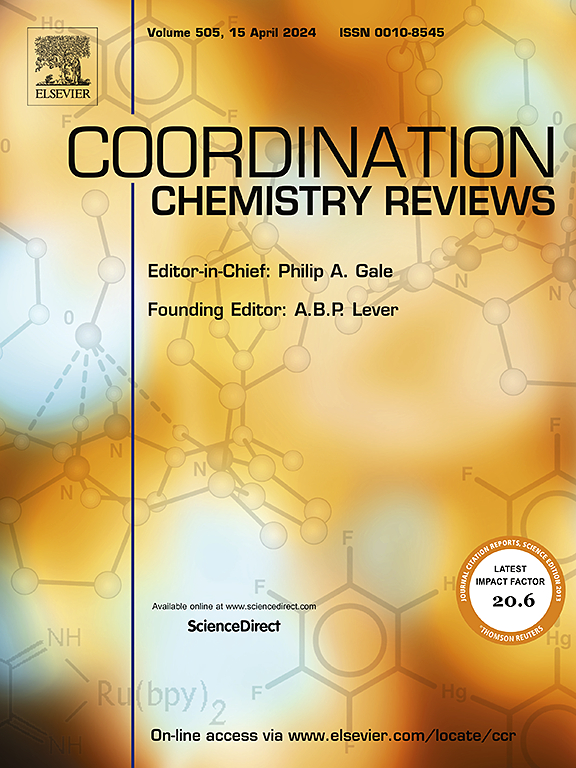Nanoarchitectured bismuth-based structures for diverse applications: Recent advancements and latest breakthroughs
IF 20.3
1区 化学
Q1 CHEMISTRY, INORGANIC & NUCLEAR
引用次数: 0
Abstract
Among various inorganics, bismuth (Bi)-based nanomaterials have gained vast interest due to their high X-ray absorption coefficient, diamagnetism, and metal-semiconductor properties, which are of specific interest in metallurgy, engineering, and medicine-related fields. Although not as popular as copper, iron, and platinum in terms of availability and features, this high atomic number (Z-value)-based Bi element offers similar properties to gold along with a low synthesis cost, facile operation, and unique properties with broad prospects, conquering a significant position among these inorganics. Despite the success in fabricating various Bi-based nanomaterials by altering their structure and shape, these materials suffer from some shortcomings, such as deprived conductivity and catalytic properties, as well as accumulation-induced safety risks and environmental pollution due to poor degradability, impacting aquatic organisms and human health. In this article, a comprehensive view of diverse Bi-based materials for various applications is provided, presenting recent advancements and the latest breakthroughs. Initially, we present the chemistry and configuration of Bi, emphasizing the feasibility for fabricating various composites. Then, we introduce various commonly used fabrication strategies of Bi-based composites, highlighting the factors affecting their morphological properties. Further, various major classes of Bi-based materials are presented, exploring the influence of structural forms and their roles in various applications. Finally, we synopsize the article with interesting perspectives, presenting challenges and opportunities that still exist for these Bi-based materials.

不同应用的纳米结构铋基结构:最新进展和最新突破
在各种无机物中,铋(Bi)基纳米材料由于其高x射线吸收系数、抗磁性和金属半导体特性而获得了广泛的兴趣,在冶金、工程和医学相关领域具有特殊的兴趣。虽然在可用性和特性方面不如铜、铁和铂那么受欢迎,但这种基于高原子序数(z值)的铋元素具有与金相似的性能,而且合成成本低,操作方便,性能独特,前景广阔,在这些无机物中占有重要地位。尽管通过改变结构和形状成功制造了各种铋基纳米材料,但这些材料存在一些缺点,例如电导率和催化性能被剥夺,以及由于降解性差而产生的积累性安全风险和环境污染,影响水生生物和人类健康。本文全面介绍了各种应用的铋基材料的最新进展和最新突破。首先,我们介绍了铋的化学性质和结构,强调了制造各种复合材料的可行性。然后,我们介绍了各种常用的铋基复合材料的制造策略,重点介绍了影响其形态性能的因素。此外,介绍了各种主要类型的铋基材料,探讨了结构形式的影响及其在各种应用中的作用。最后,我们从有趣的角度概述了这篇文章,提出了这些铋基材料仍然存在的挑战和机遇。
本文章由计算机程序翻译,如有差异,请以英文原文为准。
求助全文
约1分钟内获得全文
求助全文
来源期刊

Coordination Chemistry Reviews
化学-无机化学与核化学
CiteScore
34.30
自引率
5.30%
发文量
457
审稿时长
54 days
期刊介绍:
Coordination Chemistry Reviews offers rapid publication of review articles on current and significant topics in coordination chemistry, encompassing organometallic, supramolecular, theoretical, and bioinorganic chemistry. It also covers catalysis, materials chemistry, and metal-organic frameworks from a coordination chemistry perspective. Reviews summarize recent developments or discuss specific techniques, welcoming contributions from both established and emerging researchers.
The journal releases special issues on timely subjects, including those featuring contributions from specific regions or conferences. Occasional full-length book articles are also featured. Additionally, special volumes cover annual reviews of main group chemistry, transition metal group chemistry, and organometallic chemistry. These comprehensive reviews are vital resources for those engaged in coordination chemistry, further establishing Coordination Chemistry Reviews as a hub for insightful surveys in inorganic and physical inorganic chemistry.
 求助内容:
求助内容: 应助结果提醒方式:
应助结果提醒方式:


